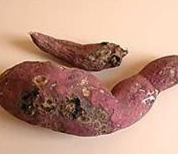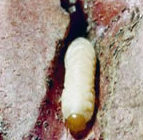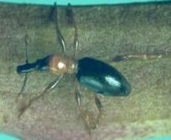Symptoms of damage:
- Thickening and malformation of vines and often cracking of the tissue.
- Discoloration, cracking, or wilting of damaged wines
- An infested tuber is often riddled with cavities or tunnels
- Attacked tubers become spongy, brownish to blackish in appearance
- Start rotting form the top and develop an unpleasant smell and a bitter taste
- Unfit for human consumption.
Identification of pest:
- Egg: Oval, yellowish-white laid singly in small cavities on the sweet potato root or base of the vine. The cavity is then sealed with a plug of the mother's excrement
- Larva: Legless grub, white in colour. Head is comparatively large and brown or pale yellow
- Pupa: Pupa is whitish in colour and pupation takes place in the feeding tunnel
- Adult: Weevils are beetles with a long pointed snout, body is slender resembling ants
|
Larval feeding  |
Infested tuber  |
Larva

|
Adult

|
|




